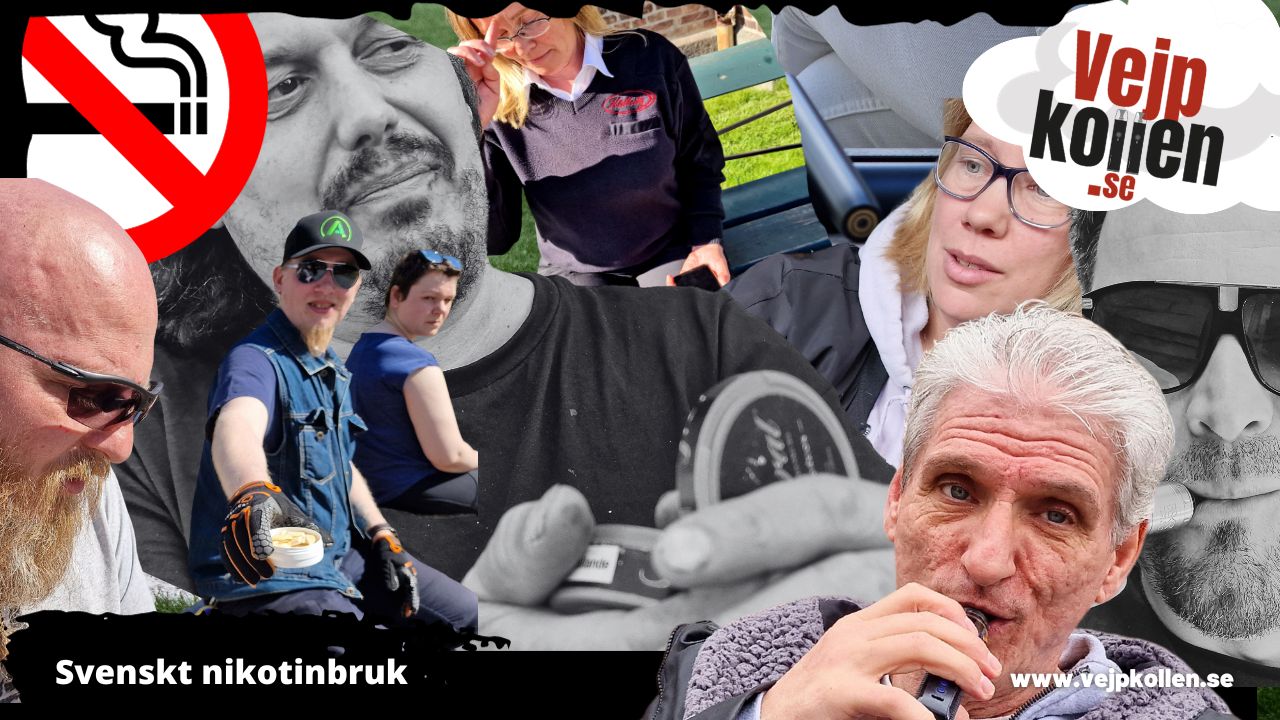How do Swedes stay smoke-free? Vejpkollen and Convenience Stores Sweden ask this question in a series of reports that can be read on Vejkollen and on Convenience Stores News.
Who are they really? The Swedes who no longer smoke. That was the starting point when I began this series of reports on nicotine use in Sweden. I wanted to interview Swedes, listen to their stories about how they relate to their nicotine use - and how the journey from the first cigarette to a smoke-free life actually happened. It ended up being eight reports, eight glimpses into everyday life, eight stories about the art of staying smoke-free in a time when nicotine use is more diverse than ever.
But why do this? Who cares about this smoker in our country in a cold corner of the world?
Sweden hardly smokes anymore
The series of articles is really an attempt to understand the reality behind the claim that Sweden will soon be a "a smoke-free country". It's a claim that is widely used, not least by those who advocate harm minimisation as a way of reducing the damage caused by smoking around the world. Because even though half a million Swedes still smoke, they are still only 6 per cent of the adult population. This is really low. According to the WHO and EU criteria, it is on the edge of the definition of "smoke-free". This is the "big goal" of WHO Tobacco Convention, a convention that saw the light of day over 20 years ago. But even though smoking is decreasing in many (western) countries, it is going faster in Sweden. Much faster even. We are far ahead of everyone else.
Tough anti-smoking policies?
I recently asked once a influential doctor who works on tobacco prevention in Sweden what he thought this was due to. He often appears as an expert at seminars organised by the think tank Tobaksfakta and as a commentator in various media. According to him, and many other active in the anti-tobacco movement, Sweden's low smoking rate is due to tough legislation and very successful tobacco prevention: bans, a few more bans and a good dose of stigmatisation. According to a unified anti-tobacco movement, smoking has disappeared because of a tough and restrictive tobacco policy, something that, coincidentally, the anti-tobacco movement has been advocating for decades.
Not a good explanation
The problem with this explanation is that Sweden has not been alone in taking this hard line against smoking. We've seen similar legislation in many other countries, basically every European country has tough rules in place, rules that are based on WHO Tobacco Convention. The EU average is 23% smokers.. In Sweden it is six per cent. Among young people, the figures are even lower. Tough rules don't seem to be the key here, it's obviously something else. Also.
The role of snus?
As as most people already know, a lot of people in Sweden use snus.. Almost 20 per cent of men. 10 per cent of women. Among young people, where less than 2 per cent smoke daily, it has continued to decline as the use of nicotine pouches and e-cigarettes increases. The use of e-cigarettes and white snus is particularly noticeable among young women, a group that has always smoked more than men in Sweden.
An alternative explanation for why so few people smoke here in Sweden seems to be the preoccupation with alternatives to cigarettesamong both adults and young people. We see a similar patterns in Norway and for those who raise their eyes and look at countries that United Kingdom, New Zealand and Japan you can see a similar patterns as in the Nordic countries. One exception is Finland, where Swedish snus has not been authorised for sale for 20 years and e-cigarettes are heavily restricted. through a ban on flavours. In Finland, 14 per cent of the population smokes. Recently, however, the Finnish government relaxed the sale of nicotine pouches, with the idea that regulate them as tobacco products.
A successful combination
I personally believe that the explanation for our low smoking rates in Sweden is not so simple that it can be found in one or the other. Behind that 6 per cent there are thousands of complicated stories. It's not just about an anti-smoking line in politics OR the availability of alternative nicotine products. Rather, it is about reactions and interactions, sometimes in line with the policy, sometimes as a counter-reaction to the policy, sometimes completely beyond the policy. How many smokers in Sweden became curious about snus and nicotine pouches since the ban on smoking in pubs became a fact? How many 20-year-olds have picked up a glossy and coloured disposable cigarette in the convenience store when going to a party, just because they look better than both cigarettes in the convenience store? This probably matters more than our authorities will ever accept. But that doesn't make it any less real.
Enjoyment and stigmatisation
A common thread is probably the realisation that water always seeks the easiest way down the mountain. Nicotine use has many dimensions. The bond that many people have with smoking is not just about an addiction to nicotine. It is just as much about a social connection, self-confidence, self-image and, of course, enjoyment. We rarely talk about smoking as something enjoyable, only as a bad habit. This is a very narrow picture, a stigmatisation, driven by an ideological fight against the tobacco industryin which leaves no room for empathy or understanding of what smoking really means to an individual. It is unfortunately indicative of a rather skewed view of human nature and a simplified view of reality.
Addiction - sink or swim?
The people in the portraits talk about these prejudices. Many are told that they "cheat" and that they have not really stopped smoking, that they have "exchanged one addiction" for another. And it's contagious. According to studies is this inAdjustment one of the most common obstacles for a smoker who cannot quit smoking. Maybe worth a series of articles in itself? Who knows?
Quitting smoking is about coming to terms with your vices. Accepting them. For some, it's easiest to just throw them overboard, for others it's about rebalancing the burden. Alternative sources of nicotine are one of many ways to let the water flow, without clogging important outlets that cause damming. Letting the load become a floatation aid, instead of a burden. If anything, more anti-smoking advocates and opinion makers should take note of this, rather than actively discourage it.
The stories of non-smokers
As I write this, the debate is raging about various restrictions on the very products that are central to the people in the portraits. Is it not on taxes it is about flavourprohibition or marketing ban. In Sweden, our politicians have voted against any such measures, by 2022.
In the stories I am trying to highlight, the availability of strawberry-flavoured e-cigarettes, citrus-scented snus and berry-sweet nicotine pouches play a crucial role. As well as tobacco-flavoured snus. It is about mums, dads, grandmothers, grandfathers, sons and daughters not smoking anymore. In a country that is almost smoke-free.





Wish smoking was over for me ... but but terribly difficult despite my lung cancer.
Plasters od. Does not help me. Champix is an anti-smoking medicine that was good but with the corona so LAS manufacturing down t.v and does not exist yet just had time to redeem the starter kit. Uses mostly e-cig which is good too but not 100% for me. But I fight on
Hi, I am 70 years old and smoked from about 17 years of age. It was cigarettes and from about 1998 also nicotine chewing gum where I was not allowed to smoke. But the desire to quit smoking was there all the time and many attempts were made🥴. But in 2018 I got a pulmonary embolism and was hospitalised for a week at the hospital and then I again saw the opportunity to make another attempt to quit smoking and I succeeded. So my advice to all smokers is "never give up" there will be a day when you get tired of the misery. And the best of all is that even my daughter has stopped everything that contained nicotine👍.
I quit smoking 2.5 years ago without any problems .I started with nicotine snuff without tobacco one day before I quit smoking .I quit completely abruptly one day had decided before so it was from I opened my eyes in the morning .I have not had the urge to smoke anything because of the white nicotine snuff .It pays off financially with .I do not snuff a can a day .Good luck
It's so much bullshit, if you want to stop smoking you shouldn't go over to another addiction, it's not the tobacco itself that's dangerous but all the additives nicotine among others. My mother put a packet of cigarettes in the fridge and never smoked again. It's all in the head. Acupuncture is also great. But vape, white snuff is more harmful, all the research says the same thing. I have seen people stand and vomit when they vape. It should be banned, the vapours are harmful to the lungs.
Karin. I don't know where you get your information, but when it comes to tobacco and nicotine, unfortunately the science is against you. There is actually a broad consensus that it is the SMOKE from burnt tobacco that is the most harmful way to use nicotine, and that the vapour from e-cigarettes (or nicotine from both traditional snus and white snus) is significantly less harmful to the lungs, blood vessels and the body in general. Unfortunately, the research, or researchers, who say otherwise have often been found to be heavily burdened by various so-called "biases". That is, for some reason, they have not treated the data correctly (or performed tests incorrectly, exaggerated risks in their analyses, etc). Often, but not always, this can be traced to specific funding or to researchers actively working to influence legislation or public opinion on the issue of nicotine. Unfortunately, I would say. We need more research and more honest information about different types of nicotine use. But to categorically say that all nicotine use is equally dangerous is just unscientific.
Having said that.
I'm glad your mum quit smoking. Many others have not had the same success with her particular method. Taping has been shown to be an effective tool for smoking cessation (e.g. Cochrane's rolling review of randomised control trials, links below).
That "people stand and vomit" when they roadmap sounds really strange. Considering how many millions of road users we have in the world today, such a phenomenon should result in really sticky streets... if what you say is true.
etc.
Stefan Mathisson
responsible publisher
Links to take advantage of:
Cochrane: E-cigarettes, varenicline and cytisine are the most effective stop-smoking aids, analysis of over 150,000 smokers reveals
https://www.cochrane.org/news/e-cigarettes-varenicline-and-cytisine-are-most-effective-stop-smoking-aids-analysis-over-150000
Cochrane: Latest Cochrane Review finds high certainty evidence that nicotine e-cigarettes are more effective than traditional nicotine-replacement therapy (NRT) in helping people quit smoking
https://www.cochrane.org/news/latest-cochrane-review-finds-high-certainty-evidence-nicotine-e-cigarettes-are-more-effective
UK Public Health Agency's annually updated report on the state of science on e-cigarettes (consensus)
Nicotine vaping in England: 2022 evidence update main findings
https://www.gov.uk/government/publications/nicotine-vaping-in-england-2022-evidence-update/nicotine-vaping-in-england-2022-evidence-update-main-findings